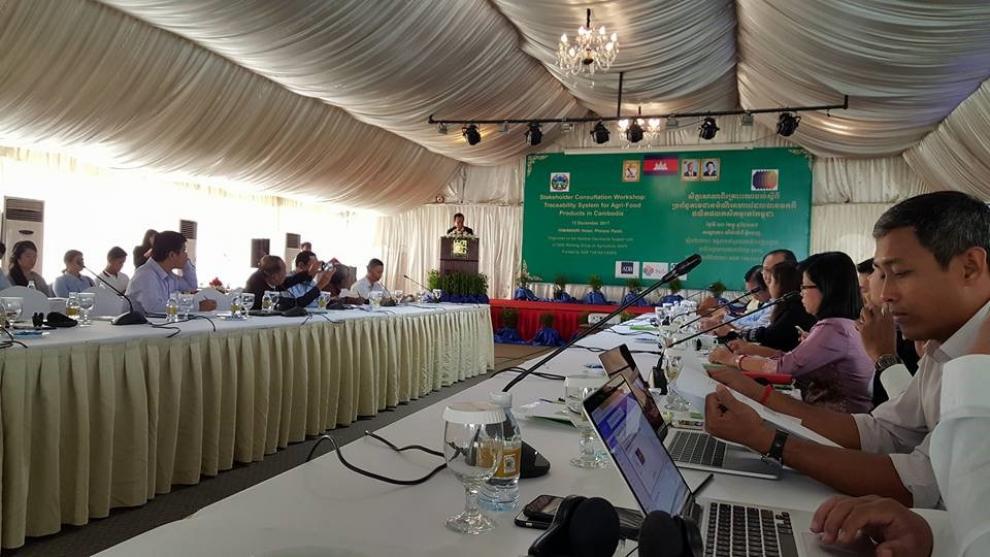
In September 2017, the agricultural policy development agenda in the GMS was about the endorsement by the Ministers of Agriculture of a Joint Statement and a GMS Strategy and Siem Reap Action Plan ( 2018-2022) for Safe and Environment-Friendly Agri-Food Value Chains. This historic meeting, the second in a decade, was preceded by two Policy Forums held in Thailand and in Cambodia, on topics including Food Safety, Public Private Partnerships, Traceability, Geographic Indications, Inclusiveness and Sustainability.
In October, the GMS Working Group on Agriculture initiated a project with the Food Industry Asia (FIA) and the GS1 as part of the follow-through activities to jumpstart the GMS Strategy and Action Plan. This project, entitled “Strengthening Agri-Food Traceability in the GMS Region”, aims to contribute to the GMS in becoming a leading supplier of safe and environment-friendly agriculture products (SEAP) in the domestic and international markets.
The project activities will develop the capacity of growers, manufacturers/processors, distributors and retailers, and governments in the GMS agricultural food supply chain to understand and adopt the GS1 system for traceability of agri-food products traded domestically and cross-border.
What is Food Traceability in the Context of Food Safety?
Traceability is the facility to monitor and track any food product through all stages of its production, processing and distribution. It can include imports, if applicable and goes up to the level of retail. Traceability means that movement of agriculture products can be traced one step back and one step forward at any point in the food supply chain. For enterprises involved in food processing, traceability also needs to include being able to identify the source of any and all food inputs such as: raw materials, additives, other ingredients and packaging.
Why is Traceability Important for Food Safety?
Traceability is like insurance. When something goes wrong, it allows products to be identified and recalled quickly and with precision to help identify and prevent contaminated products from reaching the market. Traceability can help minimize potential public health risks and trade interruption. It is thus important for all food enterprises (including retailers and importers) to be able to trace products.
Today, food safety for all is a priority concern for agricultural food policy in the GMS which has a growing population of 320 million and a growing middle class with more disposable income. This new breed of consumers is increasingly demanding better quality food; hence food safety becomes a crucial issue in the food supply chain as consumers want to trust the sources of their food supply.
There is a need to ensure food safety through the various stages of the value chain: from production to processing and distribution at wholesale and retail levels. The introduction and use of the bar code system to efficiently identify the agro-food products from “farm to shelf, then table” becomes one of the important operational means to monitor and track food safety related concerns, and protect consumers from foodborne illnesses.
This system can only be done with the active partnership between the farmers and food producers, private sector entrepreneurs, and government. Food safety regulations are in place but limited infrastructure and institutional capacity are barriers to effective food safety systems.
Introducing the GS1 Standards as Applied to the Food Supply Chain
The pilot “Strengthening Agri-Food Traceability in the GMS Region” project introduces the GS1 barcode system to be used to track food products in the food supply chain. The GS1 system provides standards that are employed internationally and inter-operable, from local to global and anywhere in between.
The farmer who grows/produces the products and who is referred to as the supplier; the cooperative or association or household entrepreneur or local enterprise which prepares the farmers’ produce into the final product by introducing processes (classifying/sorting, weighing, cleaning, etc); the distributor or consolidator who is normally a wholesaler and takes care of distribution; and finally the retailer whether it be by the roadside, at a food stall, in the market or in a grocery.
The GS1 barcode system allows for farm level identification including date of harvest/production, which can also be coded at manufacturer, distributor and retailer levels until point of sale (POS). Locations, shipping codes, delivery box numbers can all be tracked through the bar code system, which makes the food supply chain traceable and transparent, which is a requirement for regional and global markets.
The current GMS/WGA Core Agriculture Support Program Phase II project, funded by ADB and its partners, the Government of Sweden, the Nordic Development Fund and the Water Partnership Financing Facility, is introducing bar-code based traceability systems to selected GMS agricultural supply chain stakeholders in collaboration with GS1. This consists of stakeholder consultations involving producers, SME entrepreneurs and manufacturers, warehouse distributors wholesalers and retailers as well as government functionaries involved in food safety. This will be immediately followed by capability building at the country level and a pilot project to ensure that the systems are not only understood but also work efficiently and effectively.
Food Safety for all has many facets, as we have discussed previously, including monitoring food associated hazards and risks, communicating risks to stakeholders and improving management to mitigate their impacts. Traceability is a key component of an effective food safety system. Farmer producers have a primary role in improving food safety at the grassroots level. It may be recalled that the GMS vision is to a become a primary supplier of safe and environment friendly agricultural products to the global markets. So far we have primarily addressed issues surrounding food safety. The succeeding post will look into the environment-friendly aspects of the food supply chain through application of the Participatory Guarantee System (PGS).

